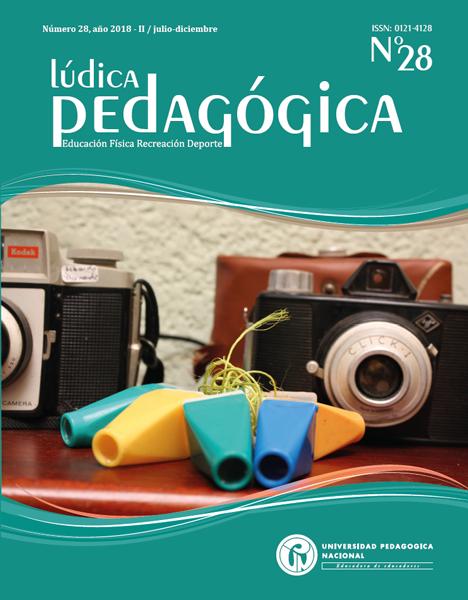Relación Entre La Repetición Máxima En Ejercicios Accesorios Y El Peso Muerto Rumano
Resumen
El objetivo del presente estudio (OE) consistió en determinar la relación entre la repetición máxima (RM) en ejercicios accesorios (EA) y el peso muerto rumano (PMR) en sujetos con experiencia en el entrenamiento de la fuerza con sorecargas. Para ello se realizó un estudio exploratorio de tipo correlacional con enfoque cuantitativo y una muestra a conveniencia de doce hombres sanos (edad 20,37 ±5,28, talla 1,72±0,12 m, peso 65,92±14,06 kg, IMC 22,98±3,93 kg/m2) capacitados en el entrenamiento de la fuerza con sobrecargas (EFS), todos firmaron un consentimiento informado que tenía detallado el OE, el test de RM y los ejercicios a ser evaluados: PMR, remo con barra, bíceps con barra, jalón a la cara en polea, encogimientos con barra, curl femoral acostado y empuje de cadera (EC), debido a que se seleccionaron dada la musculatura implicada en el PMR y la disponibilidad de equipos en el centro de acondicionamiento físico. Los datos fueron analizados en el paquete estadístico IBM SPSS V.22 con un nivel de confianza del 95% y un p-valor de 0,05, se aplicó la prueba de normalidad de Shapiro-Wilk y el coeficiente correlacional de Pearson. Los resultados obtenidos evidenciaron una distribución normal de la RM de los ejercicios (p>0,05) y una relación muy significativa entre la RM del EC y el PMR (r=0,89, p<0,01). Por consiguiente el EC en la planificación del EFS ayudara a incrementar la RM en el PMR.
Citas
Abdul-Hameed, U., Rangra, P., Yakub Shareef, M. y Ejaz Hussain, M. (2012). Reliability of 1-repetition maximum estimation for upper and lower body muscular strength measurement in untrained middle aged type 2 diabetic patients. Asian J Sports Med., 3(4), 267-273. https://www.ncbi.nlm.nih.gov/pmc/articles/pmc3525823/
Andersen, V., Fimland, M. S., Mo, D. A., Iversen, V. M., Vederhus, T., Rockland Hellebø, l. R., nordaune, K. i. y Saeterbakken, A. H. (2018). Electromyographic comparison of barbell deadlift, hex bar deadlift, and hip thrust exercises: a cross-over study. J Strength Cond Res., 32(3), 587-593. doi: https://doi.org/10.1519/jSc.0000000000001826
Asociación médica mundial (2013). Declaración de Helsinki de la amm. Principios éticos para las investigaciones médicas en seres humanos. http://www.redsamid.net/archivos/201606/2013-declaracion-helsinki-brasil.pdf?1
Berglund, l., Aasa, B., Hellqvist, J., Michaelson, P. y Aasa, U. (2015). Which patients with low back pain benefit from deadlift training? J Strength Cond Res., 29(7), 1803-1811. doi: https://doi.org/10.1519/jsc.0000000000000837
Bustos-Viviescas, B. J., Lozano-Zapata, R. E. y Justacaro-Portillo, G. A. (2016). Incremento de la fuerza dinámica máxima a través de un protocolo de acción recíproca con deportistas amateurs. Ímpetus, 10(1 y 2), 119-126. https://www.researchgate.net/publication/324731874_INCREMENTO_DE_LA_FUERZA_DINAMICA_MAXIMA_A_TRAVES_DE_UN_PROTOCOLO_DE_ACCION_RECIPROCA_CON_DEPORTISTAS_AMATEURS_-_Increase_of_force_dynamics_maxim_through_a_protocol_of_reciprocal_action_with_amateur_at
Bustos-Viviescas, B. J., Acevedo-Mindiola, A. A. y Rodríguez-Acuña, l. E. (2017). Relación entre la masa muscular apendicular y la repetición máxima en sujetos físicamente activos. Kronos, 16(2). https://g-se.com/relacion-entre-la-masa-muscular-apendicular-y-la-repeticion-maxima-en-sujetos-fisicamente-activos-2366-sa-O5a57800957910
Camara, K. D., Coburn, J. W., Dunnick, D. D., Brown, l. E., Galpin, A. J. y Costa, P. B. (2016). An examination of muscle activation and power characteristics while performing the deadlift exercise with straight and hexagonal barbells. Journal of Strength and Condi-tioning Research, 30(5), 1183-1188. doi: 10.1519/jsc.0000000000001352
Contreras, B. (2014). New research: The glute max is really good at stabilizing the si joint. http://bretcontreras.com/new-research-the-glute-max-is-really-good-at-stabilizing-the-si-joint/
Contreras, B., Vigotsky, A. D., Schoenfeld, B. j., Beardsley, C. y Cronin, J. (2015). A comparison of gluteus maximus, biceps femoris, and vastus lateralis electromyographic activity in the back squat and barbell hip thrust exer-cises. Journal of Applied Biomechanics, 31(6), 452-458. doi: 10.1123/jab.2014-0301
Correa, J. y Corredor, D. (2009). Principios y métodos para el entrenamiento de la fuerza muscular. Bogotá: Universidad del Rosario.
De Witt, J. K., English, K. l., Crowell, J. B., Kalogera, K. l., Guilliams, M. E., Nieschwitz, B. E., Hanson, A. y Ploutz-Snyder, L. L. (2018). Isometric midthigh pull reliability and relationship to deadlift one repetition maximum. Journal of Strength and Conditioning Research: The Research Journal of the NSCA, 32 (2), 528-533. doi: 10.1519/JSC.0000000000001605
Escamilla, R. F., Francisco, A. C., Kayes, A. V., Speer, K. P. y Moorman, C. T. (2002). An electromyographic analysis of sumo and conventional style deadlifts. Med Sci Sports Exerc, 34, 682–688.
Gentil, P., Fisher, J. y Steele, J. (2017). A review of the acute effects and long-term adaptations of single- and multi-joint exercises during resistance training. Sports Medicine, 47, 843. doi: 10.1007/s40279-016-0627-5
Gentil, P., Soares, S. y Bottaro, M. (2015). Single vs. multi-joint resistance exercises: Effects on muscle strength and hypertrophy. Asian Journal of Sports Medicine, 6(2), e24057. doi: http://doi.org/10.5812/asjsm.24057
Gregory Haff, G. y Travis Triplett, N. (2015). Essentials of Strength Training and conditioning (4.a ed.). United States of america: Publishing Human Kinetics.
Harriss, D. J. y Atkinson, G. (2013). Ethical standards in sport and exercise science research: 2014 update. Inter-national Journal of Sports Medicine, 34(12), 1025-1028. doi: http://dx.doi.org/10.1055/s-0033-1358756
Kompf, J. y Arandjelović, O. (2017). The sticking point in the bench press, the squat, and the deadlift: Similarities and differences, and their significance for research and practice. Sports Medicine, 47(4), 631-640. doi: 10.1007/s40279-016-0615-9.
Marchante Domingo, D. (2015). Entrenamiento eficiente: explota tus límites. Madrid: editorial luhu.
Mata, D. (2005). Efectos del entrenamiento de la fuerza. http://jlgarcia.galeon.com/tecnica/fuerza.htm
O’Reilly, M. A., Whelan, D. F., Ward, T. E., Delahunt, E. y Caulfield, B. M. (2017). Classification of deadlift biomechanics with wearable inertial measurement units. Journal of Biomechanics, 58, 155-161. doi: 10.1016/j.jbiomech.2017.04.028
Rosa Guillamón, A. (2013). Metodología de entrenamiento de la fuerza. Revista Digital EF Deportes, 18(186). http://www.efdeportes.com/efd186/metodologia-de-entrenamiento-de-la-fuerza.htm
Sánchez-Sánchez, J., Pérez, S., Yagüe, J. M., Royo, J. M. y Martín, J. l. (2015). Aplicación de un programa de entrenamiento de fuerza en futbolistas jóvenes / implementation of a Resistance Training on young Football Players. Revista Internacional de Medicina y Ciencias de la Actividad Física y el Deporte 15(57), 45-59. http://cdeporte.rediris.es/revista/revista57/artaplicacion533.htm
Sandoval-Martínez, R., Hernández-Campodónico, M., Farias-Pavez, S., Jorquera-Muñoz, J., Caro-San Juan, J., Illanes-Aguilar, l. y Aedo-Muñoz, E. Ecuación de predicción para ejercicios con pesos libres en miembro superior en jóvenes activos. Rev Horiz Cienc Act Fís., 8(1), 10-16. https://www.researchgate.net/publication/322581089_ecuacion_de_prediccion_para_ejercicios_con_pesos_libres_en_miembro_superior_en_jovenes_activos
Snyder, B. J., Cauthen, C. P. y Senger, S. R. (2016). Comparison of muscle involvement and posture between the conventional deadlift and a “walk-in” style deadlift machine. Journal of Strength and Conditioning Research. doi: 10.1519/jSc.0000000000001723
Youdas, J. W., Hartman, J. P., Murphy, B. A., Rundle, A. M., Ugorowski, J. M. y Hollman, J. H. (2017). electromyographic analysis of gluteus maximus and hamstring activity during the supine resisted hip extension exercise versus supine unilateral bridge to neutral. Phy-siotherapy Theory and Practice, 33(2), 124-130. doi: 10.1080/09593985.2016.1271848
Zweifel, M. B., Vigotsky, A. D., Contreras, B. y Njoro-rai Simiyu, W. W. (2017). Effects of 6-week squat, deadlift, or hip thrust training program on speed, power, agility, and strength in experienced lifters: a pilot study. Journal of Trainology, 6(1), 13-17. https://doi.org/10.17338/trainology.6.1_13

















